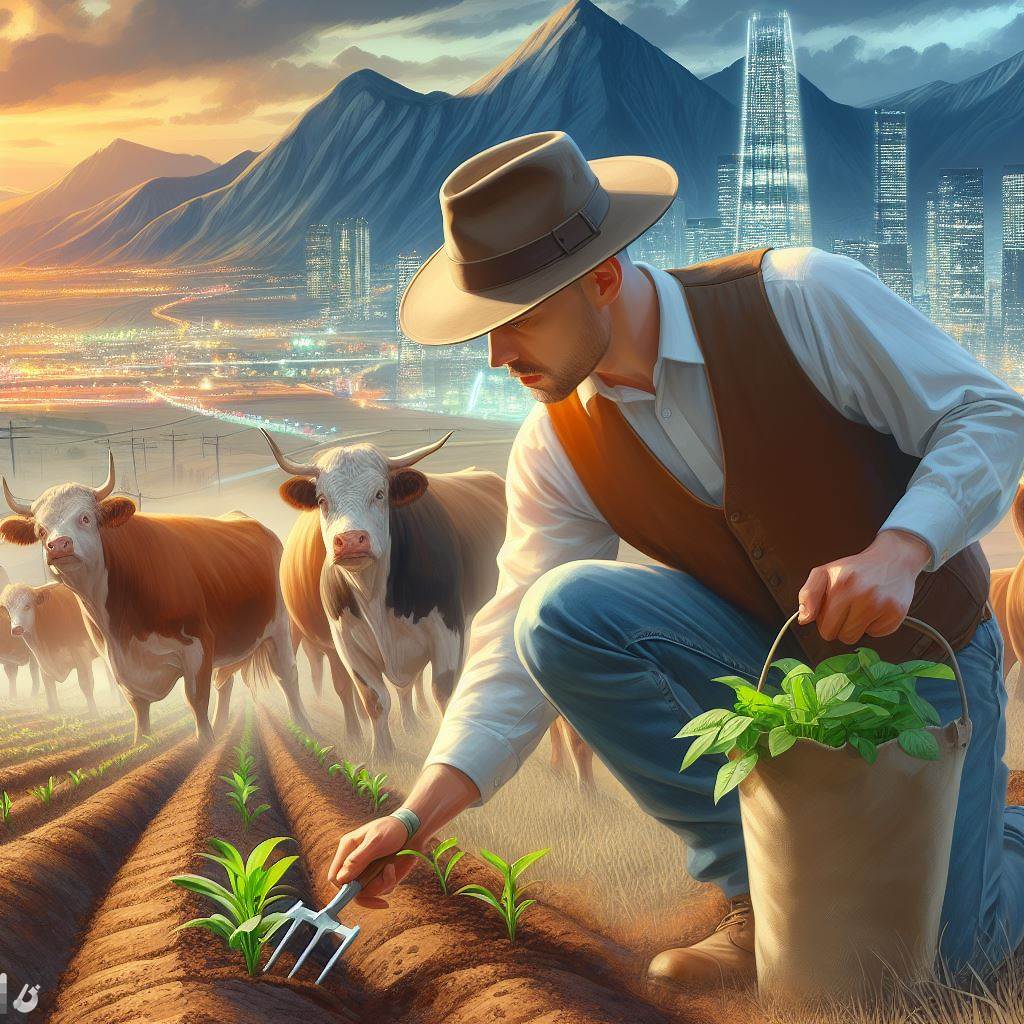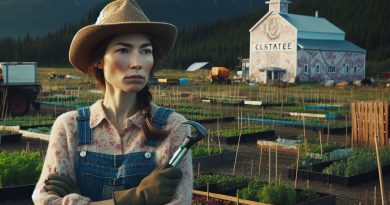Cattle Trails: A Rancher Life and Work
Last Updated on November 24, 2023
Introduction
Cattle trails are vital for ranchers as they provide a means of transportation for their livestock.
These trails play a significant role in the daily life and work of a rancher.
Understanding the importance of cattle trails and gaining an overview of a rancher’s life and work is crucial for anyone interested in this profession.
Cattle trails serve as a pathway for ranchers to move their livestock to different locations, such as markets or grazing pastures.
These trails not only ensure the safe movement of cattle but also optimize their productivity.
By using designated trails, ranchers can efficiently manage their herds, minimizing stress and reducing the risk of accidents.
A rancher’s life revolves around the care and management of cattle.
They must possess extensive knowledge of animal husbandry, including breeding, feeding, and medical practices.
Ranchers also handle various tasks such as maintaining fences, ensuring proper grazing areas, and managing herd health.
Their work requires physical stamina, patience, and a deep understanding of the land and its resources.
Ranchers are responsible for the economic viability of their operation.
Apart from the daily chores, they also need to make strategic decisions about buying or selling cattle, negotiating prices, and staying informed about market trends.
Their ability to adapt to changing conditions and make quick decisions is crucial for a successful ranching career.
In short, cattle trails are vital for ranchers as they provide a means of transportation for livestock and optimize productivity.
Understanding the importance of cattle trails and gaining an overview of a rancher’s life and work is essential for anyone interested in this profession.
Having a deep knowledge of animal husbandry, making strategic decisions, and being physically fit are key attributes of a successful rancher.
History of Cattle Trails
Cattle drives in the 19th century
In the 19th century, cattle drives played a crucial role in the ranching industry.
Ranchers would round up their cattle and drive them long distances to sell in booming markets.
These drives often lasted for several months, covering hundreds of miles.
Famous cattle trails like the Chisholm Trail and the Goodnight-Loving Trail
The Chisholm Trail and the Goodnight-Loving Trail were two of the most famous cattle trails during this time.
The Chisholm Trail, stretching from Texas to Kansas, allowed ranchers to transport their cattle to the railroads.
On the other hand, the Goodnight-Loving Trail, named after Charles Goodnight and Oliver Loving, connected Texas with Colorado.
Impact of cattle trails on the development of the ranching industry
The establishment of cattle trails had a significant impact on the development of the ranching industry.
These trails provided ranchers with a means to transport their cattle to larger markets, allowing them to expand their operations and increase profits.
The cattle trails also led to the growth of cow towns along their routes.
As drovers passed through these towns, they provided economic opportunities for merchants, saloon owners, and other businesses catering to the needs of cowboys and cattle drivers.
Additionally, the demand for beef in the expanding cities of the East fueled the need for cattle drives and the establishment of cattle trails.
With the completion of the transcontinental railroad, the transportation of cattle became more efficient, enabling ranchers to meet the growing demand.
The cattle trails brought cowboys into the spotlight, romanticizing their way of life and popularizing their image in American culture.
Cowboys became integral figures in the myth and legends of the Wild West, embodying the spirit of adventure and freedom.
However, the era of cattle drives and open-range ranching eventually came to an end.
The development of barbed wire fencing, the expansion of railroads, and the invention of refrigerated railroad cars changed the dynamics of the industry.
Ranchers began to move away from open-range grazing and focused on breeding and raising cattle on their own land.
The days of long cattle drives and the use of cattle trails were gradually replaced by more efficient and controlled methods of transportation.
Nevertheless, the history of cattle trails remains an essential part of the ranching industry. It represents a time of adventure, hardship, and innovation.
The legacy of these trails serves as a reminder of the perseverance and determination of early ranchers in shaping the cattle industry as we know it today.
Role of Cattle Trails in Ranching
Transportation of cattle to markets
Cattle trails played a crucial role in transporting cattle from ranches to markets efficiently and effectively.
Challenges faced during cattle drives
- Weather conditions: Ranchers had to brave extreme weather conditions such as storms, floods, and blizzards.
- Predators and thieves: Cattle drives were often plagued by attacks from wolves, coyotes, and theft by outlaws.
- Dangers of stampedes: The sudden frenzy and chaos of stampedes posed great risks to both cattle and cowboys.
Importance of trail bosses and cowboys
Trail bosses and cowboys were indispensable in the success of cattle trails and ranching operations.
Trail bosses, being experienced and knowledgeable, led the cattle drives, ensuring the safe passage of the herds.
Cowboys, with their exceptional riding and roping skills, helped control and manage the cattle during the long and treacherous drives.
The trail boss and cowboys must work together cohesively to navigate challenges along the cattle trails.
These individuals would often spend months away from their families, enduring harsh conditions.
Their expertise in maintaining order among the herd and dealing with unpredictable situations was critical.
Cowboys would set up and dismantle camps, guard against predators, manage food and water supplies, and maintain peace among the men.
Without trail bosses and cowboys, cattle drives would have been chaotic, posing a threat to both cattle and humans.
Their role required bravery, resilience, and a strong bond between man and animal.
Cattle trails were not only a means of transporting cattle but also a way of life for these brave ranchers.
In brief, cattle trails were vital for transporting cattle from ranches to markets.
They faced numerous challenges such as unpredictable weather, predators, and dangers of stampedes.
The role of trail bosses and cowboys in overcoming these obstacles was crucial to the success of the cattle drives and the ranching industry as a whole.
These individuals demonstrated bravery, skill, and a deep understanding of the land and animals they worked with.
Cattle trails and the people who dedicated their lives to them shaped the history and culture of ranching in America.
Read: From Seeds to Success: An Organic Farmer
Significance of Cattle Trails Today
Modern methods of transporting cattle
- The development of modern transportation methods has revolutionized the cattle industry.
- Trucks and trailers are now commonly used to transport cattle from one location to another.
- This has made the process more efficient and less time-consuming for ranchers and farmers.
- By utilizing trucks, cattle can be transported quickly and safely to their intended destinations.
- This modern method allows ranchers to transport larger quantities of cattle at one time.
Preservation and recognition of historic cattle trail sites
- Many historic cattle trail sites are preserved and recognized for their historical significance.
- These sites serve as a reminder of the hardships and challenges faced by early ranchers.
- Preservation efforts ensure that future generations can learn about and appreciate the history of cattle trails.
- By recognizing these sites, we honor the contributions of ranchers who paved the way for the cattle industry.
- Historic cattle trail sites offer educational opportunities for visitors to learn about our nation’s ranching history.
Cultural and historical importance of cattle trails
- Cattle trails hold significant cultural and historical importance in the United States.
- They symbolize the pioneer spirit and the determination of ranchers to make a living from the land.
- Cattle trails played a crucial role in the development of the American West.
- They facilitated the movement of cattle from ranches to markets, supporting the growth of the economy.
- The legacy of cattle trails has shaped the identity and culture of many western states.
In review, cattle trails hold great significance in today’s society.
Modern methods of transporting cattle have made the industry more efficient and streamlined.
Historic cattle trail sites are preserved and recognized to honor the contributions of early ranchers and educate future generations.
The cultural and historical importance of cattle trails is undeniable, as they represent the pioneer spirit and the development of the American West.
By understanding the significance of cattle trails, we can appreciate the rich history and heritage of the ranching industry.
Read: Grape Expectations: A Vintner Journey

Life of a Rancher
Daily responsibilities and tasks
Ranchers lead a demanding life filled with daily responsibilities and challenging tasks.
Each day brings a unique set of duties that must be fulfilled to ensure the well-being of the cattle and the smooth operation of the ranch.
Feeding and tending to the cattle
One of the primary tasks a rancher undertakes is feeding the cattle.
This involves providing them with nutritious food and clean water to maintain their health and growth.
The rancher must tend to the animals’ needs by regularly checking on their condition and ensuring their overall welfare.
Maintaining pastures and fences
Maintaining pastures and fences is another crucial responsibility for a rancher.
Pastures must be kept in good condition to provide ample grazing space for the cattle.
Fences need to be regularly inspected and repaired to prevent the cattle from wandering off and protect them from potential predators.
Handling medical needs of the livestock
Addressing the medical needs of the livestock is an essential task for a rancher.
They must be knowledgeable about common ailments and injuries that can affect the cattle and be equipped to provide appropriate treatment.
This involves administering medications, treating minor injuries, and consulting with veterinary professionals for more serious medical issues.
Seasonal duties
Breeding and calving season
In addition to daily responsibilities, ranchers must also manage numerous seasonal duties throughout the year.
Breeding and calving season is a critical period when ranchers encourage mating among the cattle and assist with the birthing process.
This requires careful monitoring and intervention if necessary to ensure successful breeding and healthy newborns.
Weaning and marketing of cattle
Weaning and marketing of cattle are other seasonal duties that ranchers undertake.
In this context Weaning involves separating the calves from their mothers and transitioning them to a different diet.
Once the calves reach a certain age and weight, they are ready for marketing, which involves selling them for various purposes, such as beef production or breeding.
Preparing for winter and managing resources
Preparing for winter is another important task for ranchers.
They must take stock of their resources and make necessary arrangements to ensure the cattle’s well-being during the colder months.
This includes stockpiling enough feed, providing adequate shelter, and implementing strategies to protect the livestock from harsh weather conditions.
Managing resources efficiently is vital for ranchers to maintain a sustainable operation.
They must carefully allocate and utilize their available resources, such as land, water, and equipment, to maximize productivity and profitability.
This requires careful planning, budgeting, and ongoing evaluation of the ranch’s needs and capabilities.
In general, the life of a rancher is filled with a wide range of responsibilities and tasks.
From daily duties like feeding and tending to the cattle, to seasonal obligations such as breeding and preparing for winter, ranchers play a vital role in ensuring the health and well-being of their livestock and the success of their ranching operations.
It is a demanding yet rewarding lifestyle that requires dedication, knowledge, and a deep love for the land and animals.
Read: Harvest Tales: Life in the Wheat Fields
Challenges Faced by Ranchers
Ranchers face the ongoing challenge of managing their land sustainably while ensuring profitability.
Economic challenges
Economic challenges are one of the significant issues that ranchers grapple with on a daily basis.
One of the primary challenges is dealing with fluctuating market prices for cattle. Ranchers heavily depend on selling their cattle to generate income.
However, market prices are highly volatile, influenced by factors such as supply and demand, global trade policies, and changes in consumer preferences.
These fluctuations can lead to unpredictable income for ranchers, making financial planning and stability difficult.
In addition to fluctuating market prices, ranchers also face rising costs of feed and supplies.
Cattle require a significant amount of feed, and the cost of purchasing and producing feed can fluctuate as well.
Furthermore, the price of essential supplies, such as medicine, vaccines, and equipment, continues to increase.
These rising costs directly impact a rancher’s bottom line, reducing their profit margins and putting financial strain on their operations.
Environmental challenges
Environmental challenges pose another set of obstacles for ranchers.
Droughts and wildfires are frequent natural occurrences that greatly affect their livelihoods.
Droughts limit the availability of water for cattle and forage growth.
Without sufficient water and grazing resources, ranchers may struggle to maintain their herd’s health and productivity.
Wildfires can engulf vast stretches of land, destroying pastures and valuable grazing areas, which takes a significant toll on a rancher’s ability to sustain their operation.
Disease prevention and control is yet another critical environmental challenge for ranchers.
Cattle are susceptible to various diseases that can quickly spread among the herd, causing illness and even death.
It is crucial for ranchers to implement strict biosecurity measures, conduct regular vaccinations, and closely monitor the health of their cattle.
Failing to prevent and manage diseases can result in severe financial losses and potential long-term damage to the rancher’s reputation.
Striking a balance between preservation of land and profitability
Ranchers face the ongoing challenge of striking a balance between the preservation of land and profitability.
Land is the foundation of their operations, and protecting its natural resources is essential for the long-term sustainability of their livelihoods.
However, preserving land often comes with sacrifices, such as limiting the number of cattle they can raise or implementing conservation practices that may incur additional costs.
Finding ways to maintain both environmental stewardship and profitability can be a delicate balancing act for ranchers.
In a nutshell, ranchers face a myriad of challenges in their daily lives and work.
From economic uncertainties to environmental obstacles, they must navigate through a complex landscape to ensure the success and sustainability of their ranching operations.
Read: Dawn to Dusk: A Dairy Farmer Story
Rewards and Satisfaction in Ranching
Strong Sense of Connection to Nature and the Land
Ranching offers rewards that go beyond financial gains. It provides a strong sense of connection to nature and the land.
Standing on the vast prairie, witnessing the changing seasons, and seeing cattle grazing in harmony with the environment bring a deep sense of satisfaction.
The beauty of sunsets and the serenity of open landscapes invigorate the soul.
Ranchers wake up to the sounds of birds chirping and the smell of fresh air, reinforcing their connection to the natural world.
Independence and Self-Reliance
Independence and self-reliance are essential rewards of ranching.
Ranchers have the freedom to work on their own terms, making decisions independently.
This cultivates a sense of self-reliance, as they handle challenges without relying on others.
The solitude and quietness of the ranch provide opportunities for self-reflection and personal growth.
Ranchers take pride in being accountable and responsible for their actions, supporting their independence.
Pride in Producing High-Quality Beef and Sustaining a Way of Life
Producing high-quality beef and sustaining a way of life is a source of immense pride for ranchers.
They see themselves as caretakers of the land and the animals, ensuring their well-being.
Providing families with nourishing beef brings unparalleled satisfaction.
Ranchers hold a deep connection to their heritage and take pride in preserving a traditional way of life.
Seeing the next generation continue the ranching legacy is a testament to their efforts and brings immense satisfaction.
The ranching community supports each other, fostering a strong sense of belonging within the industry.
Ranching offers rewards and satisfaction that go beyond financial gains.
It provides a strong sense of connection to nature and the land, independence and self-reliance, and pride in producing high-quality beef and sustaining a way of life.
These rewards make ranching a fulfilling and meaningful profession for those who choose this way of life.
Conclusion
Cattle trails have played a vital role in ranching, enabling the transportation of livestock and promoting economic growth.
Cattle trails, dusty highways of history, remain crucial in ranching, channeling the spirit of pioneers and the vitality of livestock.
Amidst rugged terrains, a salute to ranchers, stewards of the land, whose enduring commitment sustains the heartbeat of rural life.
Ranchers have shown immense dedication and hard work in maintaining and utilizing cattle trails to sustain their livelihood.
The legacy of cattle trails continues to shape the ranching industry by preserving traditions and ensuring its longevity.
The echo of hooves persists, emphasizing the ongoing legacy of cattle trails in shaping not just landscapes but the ethos of ranching itself.
As we bid farewell to this journey through the annals of ranching, let it be a reminder that the dust kicked up on cattle trails settles not just in the soil but in the soul of an industry forged by resilience, dedication, and a profound connection to the land.
In the vast expanse of ranching, where cattle trails fade into the horizon, the indomitable spirit of ranchers and the enduring legacy of their trails endure, etching a timeless saga in the narrative of the American West.


